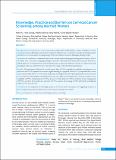Please use this identifier to cite or link to this item:
https://hdl.handle.net/20.500.14356/981Full metadata record
| DC Field | Value | Language |
|---|---|---|
| dc.contributor.author | KC, Heera | - |
| dc.contributor.author | Gurung, Alina | - |
| dc.contributor.author | Katuwal, Medina | - |
| dc.contributor.author | Sharma, Ruby | - |
| dc.contributor.author | Parajuli, Surya Bahadur | - |
| dc.date.accessioned | 2023-04-18T10:18:45Z | - |
| dc.date.available | 2023-04-18T10:18:45Z | - |
| dc.date.issued | 2022 | - |
| dc.identifier.citation | KCH., Gurung A., KatuwalM., SharmaR., & ParajuliS. B. (2023). Knowledge, Practice and Barriers on Cervical Cancer Screening among Married Women. Journal of Nepal Health Research Council, 20(3), 755-760. https://doi.org/10.33314/jnhrc.v20i3.4062 | en_US |
| dc.identifier.issn | Print ISSN: 1727-5482; Online ISSN: 1999-6217 | - |
| dc.identifier.uri | http://103.69.126.140:8080/handle/20.500.14356/981 | - |
| dc.description | Original Article | en_US |
| dc.description.abstract | Abstract Background: Cervical cancer is a most common preventable public health problem. Despite availability of various screening services at Biratnagar, many barriers restrict its utilization. So, we aimed to assess the knowledge, practice and barriers of cervical cancer screening among 30-60 years married women in Biratnagar, Morang, Nepal. Methods: We conducted a community based cross sectional study in Biratnagar Morang from December 2020 to December 2021. Consecutive sampling technique was used to collect data from 280 married women of 30-60 years. Ethical approval was obtained from Nepal Health Research Council and informed consent was taken from study participants. Data was collected by face to face interview using a semi structured questionnaire. Results: All participants had heard of cervical cancer. Most (93.9%) responded to multiple sexual partners as a risk factor and 97.9% responded to excessive vaginal bleeding as a symptom. Most (97.1%) responded that cervical cancer is preventable and 44.1% were aware of pap smear test. Eighty-four (30%) participants had ever been screened for cervical cancer. Unavailability of health insurance (85.2%), high cost of treatment (83.1%), lack of nearby service availability (70.9%), embarrassment (44.8%), presence of male doctors (43.8%), problems in time management (28.01%), no advice from health care providers (22.9%), unaware of screening (15.8%) and beliefs on traditional healers (7.1%) were barriers. Conclusions: In comparison to knowledge, practice of cervical cancer screening is low suggesting existence of know-do gap. Various barriers that prevent cervical cancer screening were evident. Keywords: Barriers; cervical cancer; knowledge; practices; screening. | en_US |
| dc.language.iso | en | en_US |
| dc.publisher | Nepal Health Research Council | en_US |
| dc.relation.ispartofseries | July-Sep, 2022;4062 | - |
| dc.subject | Barriers | en_US |
| dc.subject | cervical cancer | en_US |
| dc.subject | knowledge | en_US |
| dc.subject | practices | en_US |
| dc.subject | screening | en_US |
| dc.title | Knowledge, Practice and Barriers on Cervical Cancer Screening among Married Women | en_US |
| dc.type | Journal Article | en_US |
| Appears in Collections: | Vol 20 No 3 Issue 56 july-Sep, 2022 | |
Files in This Item:
| File | Description | Size | Format | |
|---|---|---|---|---|
| 4062-Manuscript-30789-1-10-20230314.pdf | fulltext download | 211.24 kB | Adobe PDF |  View/Open |
Items in DSpace are protected by copyright, with all rights reserved, unless otherwise indicated.
